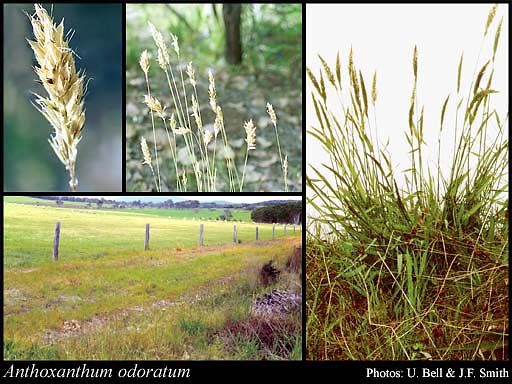- Reference
- Sp.Pl. [Linnaeus] 1:28 (1753)
- Conservation Code
- Not threatened
- Naturalised Status
- Alien to Western Australia
- Name Status
- Current
Tufted perennial, grass-like or herb, 0.1-0.8 m high (x 0.4 m wide). Fl. green-purple, Nov to Dec or Jan or Sep (occasionally). White sand, black sandy loam.

Distribution
- IBRA Regions
- Jarrah Forest, Swan Coastal Plain, Warren.
- IBRA Subregions
- Northern Jarrah Forest, Perth, Southern Jarrah Forest, Warren.
- IMCRA Regions
- WA South Coast.
- Local Government Areas (LGAs)
- Albany, Armadale, Augusta Margaret River, Bunbury, Busselton, Capel, Dardanup, Denmark, Harvey, Kalamunda, Manjimup, Plantagenet, Rockingham, Serpentine-Jarrahdale, Waroona.
Management Notes (for the Swan NRM Region)
General Biology. Growth form. Grass. Life form. Perennial, rhizomatous/caespitose. Reproduction. Seed. Dispersal. Water, wind, mammals (awns on fur), slashing, mixture with other grass fodder crops. Photosynthetic Pathway. C3. Toxicity. Can cause allergies to humans in the form of hay fever. Not directly toxic to animals, but indirect poisoning has been recorded when used in silage. Seedbank persistence. Short, up to 2 years. Fire response. Resprouts, increases in cover due to reduced competition.
Notes. Forms extensive ground cover and highly competitive with other grasses because of its rapid growth and early flowering. Produces prolific seed. Restricted to nutrient poor soils, especially those lacking phosphorous. Contains allelopathic chemicals that suppress growth of other plant species.
Additional information. Origin. Northern Africa, temperate Asia and Europe. History of use/introduction. Unknown, however it has been planted occasionally as an ornamental.
Suggested method of management and control. In small infestations hand remove plants ensuring rhizomes are removed. If all plant parts are not removed, hand removal as well as mowing can increase the number of infloresences and promote growth. Highly sensitive to glyphosate but in situations where selective control is needed, spray with grass selective herbicide in winter/spring. 2,2-DPA at 50 g/10 L + surfactant provides good control in spring when actively growing before appearance of seed head. Follow-up with seedling control. Read the manufacturers' labels and material safety data sheets before using herbicides. For further information consult the Australian Pesticides and Veterinary Medicines Authority to determine the status of permits for your situation or state.
Management Calendar
| Calendar Type | Jan | Feb | Mar | Apr | May | Jun | Jul | Aug | Sep | Oct | Nov | Dec | Comments |
|---|---|---|---|---|---|---|---|---|---|---|---|---|---|
| Dormant | Y | Y | Y | ||||||||||
| Active Growth | Y | Y | Y | Y | Y | Y | |||||||
| Germination | Y | Y | Y | ||||||||||
| Flowering | Y | O | O | Y | Y | Y | |||||||
| Fruiting | Y | Y | |||||||||||
| Optimum Treatment | O | O | Y | Y | Y | Y | O | Hand remove all year |
Legend: Y = Yes, regularly, O = Occasionally, U = Uncertain, referred by others but not confirmed.
References
- Blood, K. (2001) Environmental weeds: a field guide for SE Australia. C.H. Jerram and Associates, Melbourne.
- Brown, K. & Brooks, K. (2002) Bushland Weeds: A Practical Guide to their Management. Environmental Weeds Action Network, Greenwood.
- Clark, D.L. & Wilson, M.V. (2001) Fire, mowing and hand removal of woody species in restoring a native wetland prairie in the Waillamette Valley of Orgeon. Wetlands, 21 (1): 135-144.
- Fryer, J.D. & Makepeace, R.J. (1978) Weed control handbook, Vol. II, Recommendations. Blackwell Scientific Publications, Oxford, England.
- Gardner, D.E. & Kageler, V.A.D. (1983) Glyphosate in the control of kikyugrass, and its effects on associated native and non-native plants in Hawaiin National Parks. Technical Report 49. University of Hawaii at Manoa, Hawaii.
- Grant, M.C. & Antonovics, J. (1977) Biology of ecologically marginal populations of Anthoxanthum odoratum: I. phenetics and dynamics. Evolution, 32 (4): 822-838.
- Harris, G.S. (1961) The periodicity of germination in some grass species. New Zealand Journal of Agricultural Research, 4: 253-260.
- Hussey, B.M.J., Keighery, G.J., Dodd, J., Lloyd, S.G. & Cousens, R.D. (2007) Western Weeds. A guide to the weeds of Western Australia. 2nd Edition. The Plant Protection Society of Western Australia, Victoria Park.
- Muyt, A. (2001) Bush invaders of South-East Australia: A guide to the identification and control of environmental weeds found in South-East Australia. R.G. & F.J. Richardson, Melbourne.
- Pacific Island Ecosystems at Risk (2008) Plant threats to Pacific ecosystems. URL: http://www.hear.org/pier/scinames.htm - Accessed January 2010.
- Platenkamp, G.A.J. (1991) Phenotypic plasticity and population differentiation in seeds and seedlings of the grass Anthoxanthum odoratum. Oecologia, 88: 515-520.
- Runciman, D.J., Lee, A.M., Reed, K.F.M. & Walsh, J.R. (2008) Dicoumarol toxicity in cattle associated with ingestion of silage containing sweet vernal grass (Anthoxanthum odoratum). Australian Veterinary Journal, 80 (1): 28-32.
- USDA, ARS, National Genetics Resources Program (2009) Germplasm Resources Information Network - (GRIN). National Germplasm Resources Labaratory, Beltsville, Maryland. URL: https://npgsweb.ars-grin.gov/gringlobal/taxon/taxonomysimple.aspx - Accessed August 2009.
- Weber, E. (2003) Invasive plants of the World. CABI Publishing, CAB International, Wallingford, UK.
- Yamamoto, Y. (1995) Allelopathic potentail of Anthoxanthum odoratum for invading Zoysia - grassland in Japan. Journal of Chemical Ecology, 21 (9): 1365-1373.